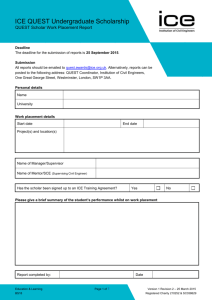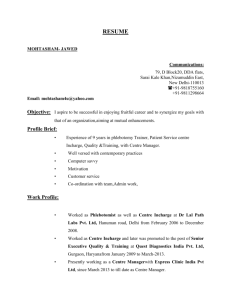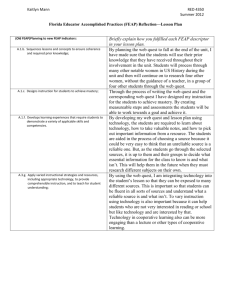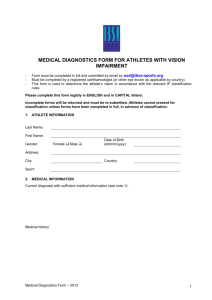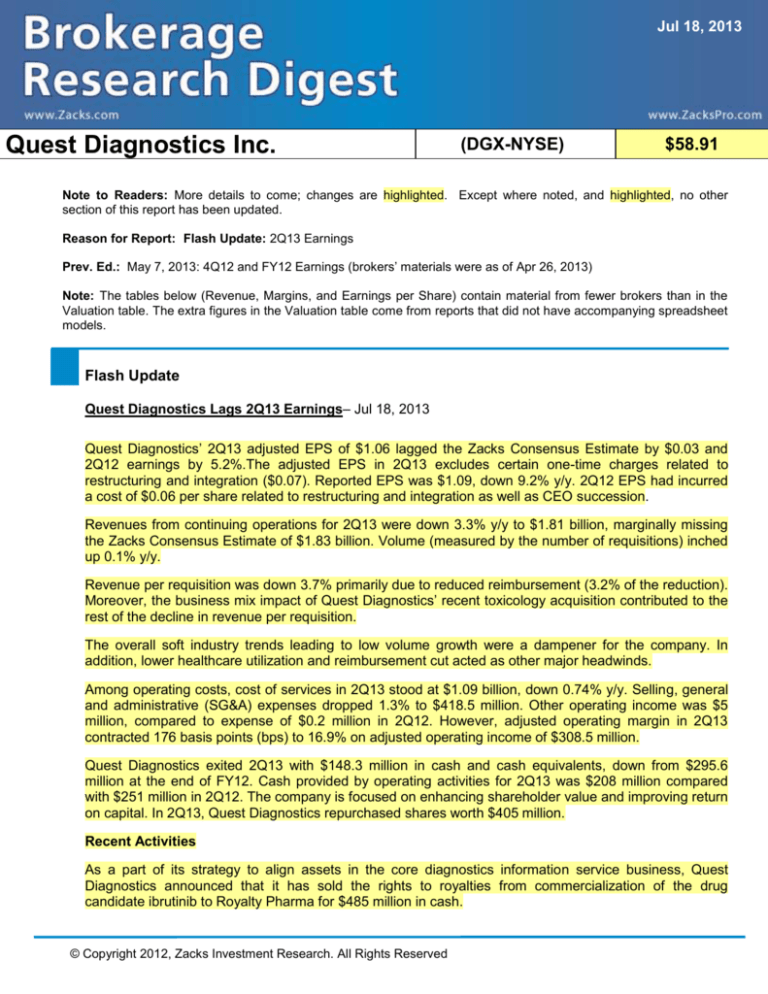
Jul 18, 2013
Quest Diagnostics Inc.
(DGX-NYSE)
$58.91
Note to Readers: More details to come; changes are highlighted. Except where noted, and highlighted, no other
section of this report has been updated.
Reason for Report: Flash Update: 2Q13 Earnings
Prev. Ed.: May 7, 2013: 4Q12 and FY12 Earnings (brokers’ materials were as of Apr 26, 2013)
Note: The tables below (Revenue, Margins, and Earnings per Share) contain material from fewer brokers than in the
Valuation table. The extra figures in the Valuation table come from reports that did not have accompanying spreadsheet
models.
Flash Update
Quest Diagnostics Lags 2Q13 Earnings– Jul 18, 2013
Quest Diagnostics’ 2Q13 adjusted EPS of $1.06 lagged the Zacks Consensus Estimate by $0.03 and
2Q12 earnings by 5.2%.The adjusted EPS in 2Q13 excludes certain one-time charges related to
restructuring and integration ($0.07). Reported EPS was $1.09, down 9.2% y/y. 2Q12 EPS had incurred
a cost of $0.06 per share related to restructuring and integration as well as CEO succession.
Revenues from continuing operations for 2Q13 were down 3.3% y/y to $1.81 billion, marginally missing
the Zacks Consensus Estimate of $1.83 billion. Volume (measured by the number of requisitions) inched
up 0.1% y/y.
Revenue per requisition was down 3.7% primarily due to reduced reimbursement (3.2% of the reduction).
Moreover, the business mix impact of Quest Diagnostics’ recent toxicology acquisition contributed to the
rest of the decline in revenue per requisition.
The overall soft industry trends leading to low volume growth were a dampener for the company. In
addition, lower healthcare utilization and reimbursement cut acted as other major headwinds.
Among operating costs, cost of services in 2Q13 stood at $1.09 billion, down 0.74% y/y. Selling, general
and administrative (SG&A) expenses dropped 1.3% to $418.5 million. Other operating income was $5
million, compared to expense of $0.2 million in 2Q12. However, adjusted operating margin in 2Q13
contracted 176 basis points (bps) to 16.9% on adjusted operating income of $308.5 million.
Quest Diagnostics exited 2Q13 with $148.3 million in cash and cash equivalents, down from $295.6
million at the end of FY12. Cash provided by operating activities for 2Q13 was $208 million compared
with $251 million in 2Q12. The company is focused on enhancing shareholder value and improving return
on capital. In 2Q13, Quest Diagnostics repurchased shares worth $405 million.
Recent Activities
As a part of its strategy to align assets in the core diagnostics information service business, Quest
Diagnostics announced that it has sold the rights to royalties from commercialization of the drug
candidate ibrutinib to Royalty Pharma for $485 million in cash.
© Copyright 2012, Zacks Investment Research. All Rights Reserved
Further, in June, the company completed the acquisition of lab-related clinical outreach service
operations of Calif.-based Dignity Health and Concentra's toxicology business. Quest Diagnostics
believes that these acquisitions remain consistent with its strategy of delivering 1%–2% growth from
acquisitions. The acquisitions are also a part of the company’s recently initiated five-pronged strategy,
which includes disciplined capital deployment.
In April, the company completed the divesture of HemoCue diagnostics products business. In December,
Quest Diagnostics divested its OralDNA Labs salivary-diagnostics business in order to refocus its
resources to core diagnostic information services.
In addition, the company’s acquisition of UMass Medical Lab in Jan 2013 is in sync with its goal to create
a planned 'lab of the future.' According to the company, this will help it increase long-term growth
opportunities in the rapidly growing esoteric markets.
Outlook
Quest Diagnostics provided an updated FY13 outlook. Currently, revenues are expected to be down 1%–
2% from the prior-year as compared to the earlier projection of flat y/y revenues. The current Zacks
Consensus Estimate of $7.28 billion remains above the guided range. EPS is expected to remain in the
range of $4.35−$4.50 (earlier band was $4.35−$4.55). The Zacks Consensus Estimate of $4.35 matches
the lower end of the range. However, the company did not alter its estimate for capital expenditure ($250
million) and cash provided by operations ($1.0 billion).
Portfolio Manager Executive Summary
Quest Diagnostics Inc. (DGX) is the leading provider of clinical laboratory services in the US. The
company has a significant market share in clinical laboratory testing (testing on body fluids such as blood
and urine), anatomic pathology (testing on tissues and organs), esoteric testing (non-routine tests), and
testing for drugs and substance abuse.
Of the 16 firms providing ratings on Quest Diagnostics, 13 firms (81.3%) assigned neutral ratings, 2
(12.5%) rendered negative ratings and 1 (6.2%) firms provided a positive rating.
Neutral and negative or equivalent outlook – 15/16 –The firms are disappointed with Quest
Diagnostics’ 1Q13 results that fell short of the Street’s estimates owing to weak volume, pricing trends
and revenue per requisition. Following poor performance in 1Q13, the company also lowered its revenue
guidance, which according to the firms seems difficult to achieve, in light of the prevailing headwinds.
Moreover, the firms are also concerned about the company missing its adjusted operating margin target
for the reported quarter. According to most of the firms, Quest Diagnostics’ disappointing FY13 guidance
indicates that although the ongoing 5-point strategy may be able to return the company to revenue
growth, it is a longer-term affair. Despite the unimpressive performance, some firms are optimistic about
the change in management. According to the firms, invigorate introduced to trim the cost is effective, but
is offset by pricing pressures. They also believe that acquisition of UMass and another outreach lab will
contribute to the revenue in a significant way. Despite this, the firms are of the opinion that multiple
expansion will depend on top-line performance. While some firms foresee positive long-term
fundamentals for the clinical lab industry and view Quest to be well placed within the industry, they
remain cautious over the near term based on inconsistent healthcare utilization trends. Additional
challenges for the company include a proposed 5% reimbursement cut effective from Jan 1, 2013, insourcing of lab testing by physician offices, which is particularly an issue for Quest, and the potential
market share loss as a result of the company’s aggressive cost-cutting initiatives. The firms are
disappointed with the company’s lack of initiatives to counter these challenges.
May 7, 2013
Zacks Investment Research
Page 2
www.zackspro.com
Overview
Based in Teterboro, N.J., Quest Diagnostics Inc. offers a broad range of clinical laboratory testing
services and advanced information technology solutions to physicians, managed care organizations,
hospitals, employers, and other independent clinical laboratories. These include routine clinical (including
substance abuse testing), anatomic pathology, and more complex esoteric testing (genetics,
immunology, and oncology). In addition, the company performs clinical lab tests in the form of research
trials for new drugs. It is one of the largest listed healthcare facilities companies in the market. More
information on the company is available at www.questdiagnostics.com.
The analysts identified the following factors for evaluating the investment merits of DGX:
Key Positive Arguments
Economies of scale, a key competitive
advantage in an industry characterized by huge
fixed costs, provide Quest with a lower cost
structure and competitive pricing power.
National level prominence gives Quest a
competitive edge in winning new business and
adding incremental volumes via opportunistic
acquisitions.
The new management’s efforts to improve
operations and execution combined with the
‘invigorate’ cost cutting initiative are expected to
rebound the company’s growth performance in
the upcoming quarters.
Key Negative Arguments
Pressure on volume owing to difficult macro
economic situation and pricing constitute the
primary risk for Quest Diagnostics.
Quest Diagnostics faces intense competition from
LabCorp, which is evident from the re-negotiation of
contracts with managed care companies at lower
prices.
The company expects the revenue per requisition to
be impacted by 3% owing to the reimbursement
pressures.
NOTE: Quest’s fiscal references coincide with the calendar year.
May 7, 2013
Long-Term Growth
Quest Diagnostics continues to face a difficult time due to general slowdown in physician office visits.
However, the company undertook several initiatives to prepare itself for an economic recovery, which
included controlling its cost structure that would improve margins over the long term and upgrading the
sales force. Moreover, the company has also adopted various cost cutting initiatives to improve its bottom
line.
The firms widely hold the view that the company’s recent change in top management is expected to
benefit the company and likely to set it on the path of growth once again. They believe that the recent
operational improvement and execution strategy of the company’s new CEO Steve Rusckowski along
with his ‘Invigorate’ cost cutting plan will help the company to improve its position even amid the difficult
industry trend. They believe that Quest's initiatives to reduce costs, enhance efficiency, and improve
productivity are encouraging.
The firms, based on the company’s positive long-term fundamentals for the clinical lab industry, view
Quest as well positioned within the industry. They are, to some extent, cautious as there has not been a
sustained recovery in healthcare utilization trends. Also, the company’s higher exposure to physician insourcing trends and limited financial flexibility after recent acquisitions emerge as points of concern.
Zacks Investment Research
Page 3
www.zackspro.com
The company has also organized specialty sales force that would cater to physicians, hospitals and
cancer patients. Moreover, the deals with Athena and Celera have brought in specialty sales force for
neurological disorders and cardiovascular diseases. Quest has been investing in esoteric, gene-based
and anatomic pathology to demarcate cancer diagnostics from cardiovascular disease, infectious disease
and neurological disorders. The company believes that these four platforms with specialty force will act
as the growth engine for the future. The company is already witnessing some traction from these steps,
which should further lead to gradual top-line growth and margin expansion.
Increased knowledge of a disease at the genetic level and the emergence of biological therapeutics have
increased the importance of early detection of ailments and the role of mainstream clinical testing.
Consequently, clinical laboratories are increasingly providing more sophisticated and high-value
specialties such as gene-based and esoteric testing, in addition to the traditional high-volume serum
testing. The fragmented US laboratory testing market has been valued at approximately $50 billion in
which Quest Diagnostics holds approximately 15% market share. Demand is expected to grow further
with the rise in aging population, increased recognition of the value of more specialized and sophisticated
tests in genomics and proteomics and the low-cost benefits of testing to improve health.
May 7, 2013
Target Price/Valuation
Rating Distribution
Positive
6.2%↑
Neutral
81.3%↓
Negative
12.5%↑
Avg. Target Price
$59.16 ↓
Maximum Target
$65.00↑
Minimum Target
No. of analyst with target
price/Total
$53.00↓
Average upside from current
4.9%↑
Maximum upside from current
15.7%↑
Minimum downside from current
5.6%↓
16/16
Risks to the target price include acceleration of pricing competition as a way to gain incremental volumes,
slow development of esoteric tests which generate the highest revenue per test, and government
reimbursement, which could come under pressure for the next several years.
Recent Events
On Apr 17, 2013, Quest Diagnostics reported its 1Q13 results. Highlights are as follows:
Quest Diagnostics reported 1Q13 EPS from continuing operations of $0.72, down from
$0.97 in 1Q12. However, after taking into account certain charges related to restructuring
and integration ($0.17), adjusted EPS from continuing operations came in at $0.89, down
15.2% y/y.
Revenues from continuing operations for 1Q13 were down 6.4% y/y to $1.8 billion.
Zacks Investment Research
Page 4
www.zackspro.com
Quest Diagnostics expects revenue growth to be flat y/y, in comparison with previously
provided band of 0%–1%. The company reiterated the EPS to be in the range of
$4.35−$4.55 and expects to incur $250 million of capital expenditure and $1.0 billion as
cash provided by operations.
Revenue
Quest Diagnostics reported net revenues from continuing operations for 1Q13 of $1.8 billion, down 6.4%
y/y. Decrease in revenue is attributable to low number of requisitions, lesser business days and
unseasonably mild winter, partially offset by contribution from the UMass acquisition. According to the
Zacks Digest, 1Q13 revenue was approximately in line with the company’s report.
Provided below is a summary of revenue as compiled by Zacks Digest:
Revenue ($ in million)
Total Revenue
Digest High
Digest Low
YoY Growth
1Q12A
2012A
1Q13A
2Q13E
3Q13E
4Q13E
2013E
2014E
2015E
$1,908.7
$7,382.7
$1,786.6
$1,839.9↓
$1,858.6
$1,829.2
$7,318.4↓
$7,437.6↓
$7,434.8
$1,908.7
$7,383.0
$1,787.0
$1,863.2↓
$1,901.5
$1,854.2
$7,405.5↓
$7,585.3↓
$7,434.8
$1,908.7
6.4%
$7,382.6
-0.1%
$1,786.6
-6.4%
$1,804.3↓
-2.0%↓
$1,834.0
2.0%
$1,809.0
3.1%
$7,253.4↓
-0.9%↓
$7,366.7↓
1.6%
$7,434.8
0.0%
5 Point Strategy
In 2012, Quest Diagnostics introduced a five-point business strategy. The points being:
1. Refocus on diagnostic information services: During 2012, the company conducted a review of
portfolio, to evaluate all strategically fit assets. As a result of the review, Quest Diagnostics has been
focusing on areas with high potential such as gene-based esoteric testing for cancer, cardiovascular
disease, infectious disease and neurological disorders. The company has experienced increasing
demand for gene-based and esoteric tests compared with routine tests on the back of increased esoteric
mix contributed by Athena and Celera. In addition, the company decided to refocus on the electronic
health record business as well as wants to pursue partnerships with top EHR vendors to jointly
strengthen value proposition. Also, it sold the OralDNA salivary diagnostics business and HemoCue
diagnostic products business.
2. Drive Operational excellence: The company plans to focus on four strategic requirements which are to
enhance end-to-end customer value chain, enterprise information technology architecture, business
performance tools and cost excellence.
Cost excellence Program: In 2012, Quest Diagnostics launched a multi-year Invigorate program
designed to support its $600 million in cost savings by the end of FY14. The company is pursuing
opportunities to increase this total to $1 billion beyond 2014. Invigorate consists of six flagship programs,
with structured plans in each, to drive savings and improve performance across the customer value
chain: organization excellence; information technology excellence; procurement excellence; service
excellence; lab excellence; and billing excellence. This effort is expected to improve operating profitability
and quality. As per the plan, the company expects roughly one-third of the savings from client
support/billing, procurement and supply chain; one-third from laboratory operations and specimen
acquisition; and one-third from selling, general and administrative expenses, including information
technology. Common themes across many of the opportunities include standardizing systems and
processes and data bases, increased use of automation and technology, and centralizing and selective
outsourcing of certain activities.
The company also announced a voluntary retirement program which is expected to deliver $40 million in
annualized cost savings, a portion of which will be realized in at the end of 1Q13. Of the total estimated
pre-tax charges for employee separation costs noted below, we expect to incur approximately $50 million
Zacks Investment Research
Page 5
www.zackspro.com
in connection with the voluntary retirement program, approximately $44 million of which has been
incurred through December 31, 2012.
On Jan 1, 2013, most of the organizational changes became operational, according to which the
company plans to remove three management layers. 400 to 600 management positions are planned to
be eliminated by the end of FY13.
3. Restore Growth: The company has adopted seven tactical approaches to restore growth such as sales
and marketing excellence; grow esoteric testing through a disease focus; partner with hospitals and IDNs
succeed internationally; create value from information assets; lead in companion diagnostics; and extend
in adjacent markets.
The other two parts of the strategy are: Simplify the organization to enable growth and productivity and
Deliver disciplined capital deployment and strategically aligned accretive acquisitions.
Segmental Revenues
Over 90% of Quest Diagnostic’s revenues are derived from DIS with the balance derived from risk
assessment services, clinical trials testing, diagnostic products and healthcare information technology.
The company is currently the leading provider of DIS, including routine testing, esoteric or gene-based
testing and anatomic pathology testing. In addition, the company also offers healthcare organizations and
clinicians information technology solutions.
DIS Revenues (90% total revenues in 1Q13)
In 1Q13, DIS revenues decreased 6.7% y/y. Volume (measured by the number of requisitions) and
revenue per requisition, each declined 3.4% y/y. Sequentially, revenue per requisition declined 3.4% in
1Q13 in comparison with 2% in 4Q12. The decrease in the revenue per requisition is primarily due to the
reduction in commercial fee schedule, Medicare fee schedule and pathology reductions. These
implementations were made effective in Jan.
The firms are concerned with the weak volume growth over the last few quarters. According to them, for
FY13, the average reimbursement pressure will be around 3% while till 2015 reimbursement pressure in
the range of 1% and 2% is expected.
Routine testing refers to the traditional testing of bodily health indicators/parameters, and forms the bulk
of the company’s revenue. This service carries low margins and represents the commodity-like aspect of
Quest’s business, and is an area that benefited from economies of scale and increased automation.
Commonly carried out tests include blood cholesterol level tests, complete blood cell counts, HIV-related
tests, urinalyses, pregnancy and other prenatal tests, alcohol and substance-abuse tests. Anatomic
pathology (including cyto-pathology, e.g. pap smears), or the analysis of human tissue, is a sub-category
and represents approximately 20% of the routine market.
Esoteric testing, by contrast, broadly refers to more complicated tests requiring sophisticated
technology, materials and hands-on professional expertise. The tests experienced a low volume and are
generally not cost effective for most clinical labs to perform. Nonetheless, their complexity attracts a
generally higher reimbursement than routine tests.
The company has experienced increasing demand for gene-based and esoteric tests compared to
routine tests. However, revenues derived from anatomic pathology have been under pressure for the
past few quarters due to in-sourcing of the tests by physicians. Many health plans have made
reimbursement policy changes to address over utilization caused by in-sourcing of certain kinds of
anatomic pathology testing.
Zacks Investment Research
Page 6
www.zackspro.com
Divesture of businesses
As a part of the company’s refocus on DIS, the company recently shed its OralDNA Labs salivarydiagnostics business. Also in Feb 2013 the company announced that Radiometer Medical ApS has
agreed to purchase the HemoCue diagnostic products business for $300 million plus customary
adjustments for cash balances. This would enable the company to refocus its attention on its core
diagnostic information services. Moreover, Quest Diagnostic’s acquisition of UMass Medical Lab is in
sync with its goal to create a planned 'lab of the future' will help it increase long-term growth opportunities
in the faster-growth esoteric markets.
Diagnostic Solutions group (10% total revenues in 1Q13)
This group includes offers a range of solutions for insurers and healthcare providers. The products are
basically healthcare information technology, clinical trials testing, life insurer services and diagnostic
products. Accordingly the company has become the leading provider of risk assessment services for the
life insurance industry. In addition, Quest Diagnostics is a leading provider of testing for clinical trials. In
addition, it offers healthcare organizations and clinicians information technology solutions. For 1Q13,
revenue from Diagnostic Solutions group decreased 2% in comparison with the year-ago quarter.
Following is a graphical representation of segmental revenue:
Please refer to the Zacks Research Digest spreadsheet on DGX for further details on revenue.
Reimbursement Headwind: Medicare (catering to patients of 65 years and older), Medicaid (for lowincome patients) and other insurers have increased their efforts to control the cost, utilization and delivery
of health care services. The company noted that steps taken to regulate health care delivery in general
and clinical laboratories in particular have resulted in reduced prices, added costs and decreased test
utilization for the clinical laboratory industry by increasing complexity and adding new regulatory and
administrative requirements.
Zacks Investment Research
Page 7
www.zackspro.com
In March 2010, the Patient Protection and Affordable Care Act (“PPACA”) was enacted, and among its
provisions were reductions in the Medicare clinical laboratory fee schedule updates, one of which is a
permanent reduction and the other to be applied in 2011 through 2015.
The Medicare Clinical Laboratory Fee Schedule for 2013 is decreased by 2.95% (excluding
sequestration) from 2012 levels. In Dec 2012, Congress delayed by one year a potential decrease of
approximately 26% in the physician fee schedule that otherwise would have become effective from Jan 1,
2013, but implemented relative value unit changes significantly impacting physician fee schedule
reimbursement for tissue biopsies that are expected to reduce reimbursement for tissue biopsy services.
Also, an additional 2% reduction in the Medicare Clinical Laboratory Fee Schedule for 2013, associated
with sequestration, has been delayed till Apr 1, 2013.
Quest Diagnostics currently derives 13% and 3% of its revenues from clinical lab fee schedule and
physician fee schedule, respectively. The company expects to record a negative impact of $40–$50
million on its revenues, which will largely be offset by the benefits from payroll rationalization.
Margins
Among operating costs, cost of services in 1Q13 stood at $1.09 billion, flat y/y. Selling, general and
administrative (SG&A) expenses dropped 9.3% to $447.9 million. Other operating income was $0.6
million, compared to expense of $0.4 million in 1Q12. Adjusted operating margin in 1Q13 contracted
120 basis points (bps) to 15.2% on adjusted operating income of $271.5 million.
According to the Zacks Digest, 1Q13 operating margin was in line with the company’s report.
Provided below is a summary of margins as compiled by Zacks Digest:
Margins
1Q12A
2012A
1Q13A
2Q13E
3Q13E
4Q13E
2013E
2014E
Gross
Operating
Pretax
Net
42.1%
41.6%
39.9%
40.5%↓
41.0%
40.7%
40.5%↓
41.0%↓
2015E
16.6%
17.8%
15.2%
17.4%↓
18.5%
17.6%
17.2%↓
17.7%↓
18.3%
15.1%
16.1%
13.5%
15.9%↑
16.9%
15.6%
15.5%↓
16.1%↓
16.8%
8.8%
9.5%
8.0%
9.1%↓
9.9%
9.5%
9.2%↓
9.6%↓
10.0%
Outlook: For FY13, Quest Diagnostics expects operating margin, to remain in between flat and down
100 bps based on the amount of share repurchase.
As per the Zacks Digest model, on a pro forma basis cost of service would go up 0.9% y/y in FY13 and
1.0% in FY14; and SG&A expense would decline 2.9% y/y in FY13 and a marginal decline of 0.2% in
FY14. In comparison, revenues would decline 0.9% y/y in FY13 and increase 1.6% y/y in FY14.
Please refer to the Zacks Research Digest spreadsheet on DGX for further details on margins.
Earnings per Share
Quest Diagnostics reported from continuing operations of $0.72 in 1Q13, down considerably from $0.97
in 1Q12. However, after taking into account certain charges related to restructuring and integration
($0.17), adjusted EPS from continuing operations came in at $0.89, down 15.2% y/y. The 1Q13 EPS had
incurred a cost of $0.08 per share each, related to restructuring and integration as well as CEO
succession costs.
According to the Zacks Digest, 1Q13 adjusted EPS were in line with the company’s report.
Provided below is a summary of EPS as compiled by Zacks Digest:
Zacks Investment Research
Page 8
www.zackspro.com
EPS ($/share)
Digest High
Digest Low
Digest Avg.
Digest Y/Y
Growth
1Q12A
2012A
1Q13A
2Q13E
3Q13E
4Q13E
2013E
2014E
2015E
$1.06
$1.05
$1.05
$4.39
$4.36
$4.37
$0.89
$0.89
$0.89
$1.13↓
$0.98↓
$1.08↓
$1.27
$1.17
$1.21
$1.21
$1.11
$1.16
$4.43↓
$4.26↓
$4.35↓
$4.98↓
$4.74↑
$4.85↓
$5.35
$5.35
$5.35
16.4%
1.7%
-15.5%
-6.6%↓
4.6%
15.1%
-0.4%↓
11.5%↑
10.3%
Outlook: Quest Diagnostics’ FY13 EPS is expected to remain in the range of $4.35−$4.55.
Please refer to the Zacks Research Digest spreadsheet on DGX for further details on EPS.
May 7, 2013
StockResearchWiki.com – The Online Stock Research Community
Discover what other investors are saying about Quest Diagnostics, Inc. (DGX) at:
DGX profile on StockResearchWiki.com
Analyst
Urmimala Biswas
Copy Editor
Content Ed.
No. of brokers reported/Total
brokers
Reason for Update
Urmimala Biswas
QCA
Rajiv Mukherjee
Lead Analyst
Urmimala Biswas
Zacks Investment Research
Flash
Page 9
www.zackspro.com


